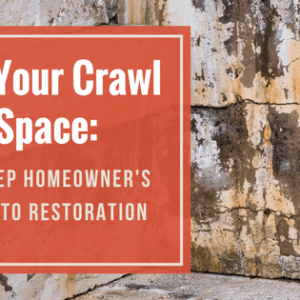Basements are not a common feature in San Diego homes, but many houses built in San Diego County up until the mid 1900s were built on top of a crawl space. Ignoring your crawl space is a mistake and could lead to problems seeping into the interior of your home affecting your home & family’s health.
A damp crawl space can cause moisture related issues such as:
- Peeling paint
- Mold and mildew which can creep up into the home and cause health issues
- Wood rot to beams leading to loss of structural integrity
How to Prevent Moisture Issues in Your Home’s Crawl Space
Every homeowner with a crawl space on their property should know what lies beneath their home. Routine visual inspections of your home’s crawl space is an important component of ensuring a healthy crawl space environment. If you see moisture on wood beams or smell a damp crawl space odor, it is time to call in a restoration company to evaluate the situation.
There are a few surefire ways that can help you maintain a safe and healthy environment while preventing unseen damage to your home.

1. Create Better Drainage Around Your Home
Pooled water around your home can wreak havoc on your home’s foundation, but when you have a crawl space, small moisture issues lead to costly repairs and restoration projects to remove moisture, replace damaged joists, and more.
The simplest way to create better drainage around your home include:
-
- Making Sure Water From Rain Does Not Pool Around Your Home
If your home collects rainwater puddles in areas too close to your home, it might be a good idea to invest in a rain harvest system. A rain harvest system may not only save your crawl space and foundation, but will save you money on your water utility bill.
-
- Making Sure Gutters and Downspouts Are Not Too Close to the House.
Gutters should slope a quarter of an inch for every ten feet of gutter. Make sure gutter is installed properly – poorly installed gutters will sag and pull on the entire gutter system causing it to be pulled off your home.
2. Insulate Exposed Foundation Walls
Insulating exposed foundation walls in your crawl space protects it from outside moisture being drawn into the space and becoming trapped under your home.
3. Cover Crawl Space Floor
Covering your crawl space floor protects your home from moisture coming up from the ground. You should use a moisture barrier plastic in this process.
However, do not fall under the trap of trying to protect everything, then end up creating a bigger problem. If moisture barrier is installed, make sure not to include wooden floor joists. Covered floor joists create condensation underneath the moisture barrier causing many costly issues including:
- wood rot
- mold & mildew growth
- foundation damage
What To Do If You Suspect Damage
Whether you are preventing crawl space moisture or looking to restore your crawl space and home from moisture damage, call a professional to help and avoid the headache of costly DIY mistakes. Visual inspections underneath your home, done on a regular basis, should be included in every homeowner’s maintenance checklist.


